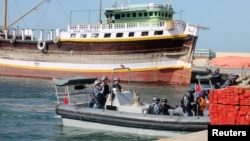A Chinese navy contract to upgrade telecom services on islands in the disputed South China Sea confirms the Beijing government’s intent to step up its control of the waterway for gains in research, exploration and military coordination, analysts say.
A naval fleet has signed agreements with the three biggest telecom operators to upgrade the “civil communication system” in the Paracel and Spratly island chains, the official Xinhua News Agency said Friday. The islets and reefs will get 4G services by May, it said.
China is the most militarily powerful country in a six-way sovereignty dispute over the 3.5 million-square-kilometer sea stretching from Hong Kong to Borneo. Brunei, Malaysia, the Philippines, Taiwan and Vietnam claim all or parts of the sea. They periodically chafe with China as it develops some of the islets for military use.
The 4G upgrades show that China will step up an existing technological advantage in the dispute to help tiny populations of citizens who live there, possibly as incentives to stay at their isolated posts, analysts say.
“I imagine that those living there would want such services and also that the government would want to ensure that individuals living in such a strategically significant location were well provided for,” said Jonathan Spangler, director of the South China Sea Think Tank in Taipei.
A stable resident population would in turn advance China's hold over the sea in a range of fields, analysts believe.
“That will give them wider options to put different teams to the area, for scientific research, for fisheries and probably for disaster relief efforts in the future,” said Alexander Huang, strategic studies professor at Tamkang University in Taiwan.
Claimant governments look to the South China Sea for its abundant fisheries as well as reserves of oil and natural gas. About one-third of the world’s marine shipping traffic passes through the sea.
Trend of technological development
China controls the whole Paracel chain of about 130 islets, including partly submerged reefs, despite a competing claim by Vietnam. About 1,400 people live on Woody Island, a larger holding in the chain, along with an airstrip.
Beijing's government holds seven islets in the more remote Spratly chain, where a U.S. think tank says it has installed infrastructure for fighter jets as well as radar systems. In December China tested a home-built seaplane. It was already working on an undersea observation network.
Quality of life
Stronger telecom signals will raise the quality of life for people on the islets that are otherwise cut off from the Chinese mainland due to location, said Lin Qi, assistant researcher with the National Institute for South China Sea Studies in Hainan province of China.
“Whether mobile phones or getting online, both are basic necessities in life, so this measure, the service of building (4G networks) in the Spratly Islands is for improving the lives of long-term residents,” Lin said.
The stronger network might eventually help Chinese-run schools, hospitals, and other facilities “where internet connectivity is standard in many countries,” Spangler said. Also possibly on the list: tourism cruise ships and oil exploration vessels.
The 4G upgrades will increase the number of telecommunication base stations on some islands and reefs, Xinhua said. It cited “improvements in the living conditions for civilians and military on the islands and reefs” as well as for maritime humanitarian relief and other jobs at sea.
Military role
The military will be able to use the improved network as needed, said Collin Koh, maritime security research fellow at Nanyang Technological University in Singapore.
A 4G network would help coordination between garrisons at sea in wartime or peace time, Koh said. Soldiers would have “closer contact” with family in mainland China, he said, a boost for their “quality of living.”
But Chinese search and rescue teams, likewise the military, already have their own communication networks, such as satellite uplinks, some experts say. “It seems there’s no military use for this (upgrade),” Lin said.
Deployment of 4G signals that China is extending its reach into the sea at a broad level, Koh said.
“What China is doing is somewhat of a bigger scale,” he said. “I think what we’re seeing here is a more concerted Chinese effort to boost its hold in various aspects, be it in coast guard, naval, military build-up, fortifications, building out of infrastructure, and now we are talking about telecoms infrastructure as such.”
Vietnam may follow China’s 4G lead, Koh said. It spars vigorously with China for fossil fuel exploration, a contest that led to a boat-ramming incident in 2014 and a diplomatic spat in mid-2017.






